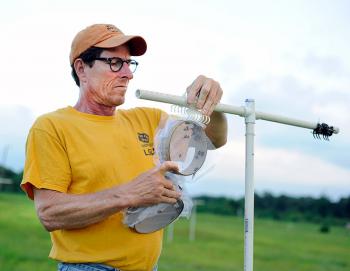
LSU AgCenter entomologist Jim Ottea attaches a container of bees to a stand as part of a field study.
--Olivia McClure photo
Entomologists studying insecticide effect on bees
BATON ROUGE — The LSU AgCenter is always buzzing with research, and this project is no exception — literally.
AgCenter entomologists Kristen Healy and Jim Ottea are studying how insecticides used for mosquito control affect honeybees. They hope to develop better management practices for beekeepers and mosquito control practices that are safer for bees.
The project is funded by a $168,000 grant from the Environmental Protection Agency that was awarded in January. Healy and Ottea are collaborating with scientists at East Baton Rouge Parish Mosquito Abatement and Rodent Control and the U.S. Department of Agriculture’s Honey Bee Breeding, Genetics and Physiology Research Laboratory in Baton Rouge.
While bees are particularly sensitive to insecticides, Healy said, they normally are not in much danger because they are in their hives at night when mosquito trucks spray. “Normally” is the key word. In hot Louisiana summers, bees sometimes must go outside their hives to cool off.
Because bees spend most of their time at night inside hives, they do not come in contact with insecticides often enough to build up any resistance. Mosquitos must be controlled because they carry public health concerns, Healy said, but there are steps beekeepers can take to minimize harm to bees.
To identify what strategies might be best, Healy and Ottea are doing field studies to learn more about how different insecticides at different doses affect bees and mosquitos. With help from entomology students, postdoctoral researchers, USDA agricultural engineers and parish employees, they clamp containers of bees and mosquitos to T-shaped stands in a field.
A mosquito truck sprays the area, and the insects are collected after 15 minutes. They are then transferred to a lab, where they are monitored for 48 hours.
Mosquito trucks’ spray reaches about 300 feet out, so one option may be to simply keep beehives a sufficient distance from the road. However, bees also face risks from aerial spraying, which is harder to protect from. Adding vents to hives could help, Healy said.
Insecticides are probably not the main reason why, but bees are in danger globally, making it important to study things that can hurt them.
“Mites, viruses and habitat loss are all contributing to an overall bee population decline,” Ottea said.
That is scary, he said, because bees are responsible for pollinating about one-third of every mouthful of food people eat.
Gathering data on one piece of the puzzle helps in the big picture as scientists work to help sustain healthy bee populations.
“People like bees,” Healy said. “They’re charismatic, and they produce honey. But they’re also extremely important because they pollinate a lot of the world’s crops.”
- Log in to post comments
